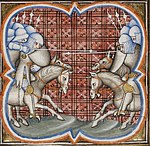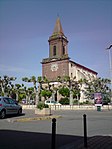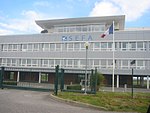Château de Rudelle
The Château de Rudelle is a 16th and 17th century castle in the commune of Muret in the Haute-Garonne département of France.The castle is noted for its ancient chimneys and for murals painted on the third floor. It was built by Guillaume de Rudelle, the son of Jean de Rudelle, a counsellor to the king. In 1783, Jean-Marie-Joseph Ingres, the father of the famous artist Jean-Auguste-Dominique Ingres, stayed there and painted several ceilings. At the French Revolution, the property was taken as a national asset and sold at auction.The building today has a reactangular plan within square towers at each corner. On the south, a square tower projects slightly. On the top floor, immediately below the roof, is a series of arcades on the north and south façades. Mullioned windows decorate the façade. The upper floors are reached by a wooden spiral staircase.Privately owned, it has been listed since 1979 as a monument historique by the French Ministry of Culture.
Excerpt from the Wikipedia article Château de Rudelle (License: CC BY-SA 3.0, Authors).Château de Rudelle
Chemin de la Briquetterie, Muret
Geographical coordinates (GPS) Address External links Nearby Places Show on map
Geographical coordinates (GPS)
| Latitude | Longitude |
|---|---|
| N 43.451944444444 ° | E 1.3105555555556 ° |
Address
Château de Rudelle
Chemin de la Briquetterie
31600 Muret
Occitania, France
Open on Google Maps









